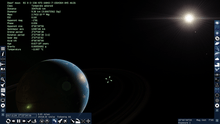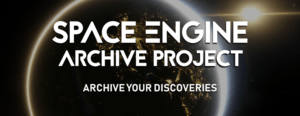SpaceEngine
SpaceEngine (stylized as "Space Engine") is a 3D astronomy program[2] and game engine developed by Russian astronomer and programmer Vladimir Romanyuk.[3] It creates a three-dimensional planetarium representing the entire universe from a combination of real astronomical data and scientifically-accurate procedural generation algorithms. Users can travel through space in any direction or speed, and forwards or backwards in time.[4] SpaceEngine is in beta status and is currently freeware for Microsoft Windows. SpaceEngine's latest release, version 0.990 beta, is the first paid edition (released on Steam).
SpaceEngine's logo | |
| Original author(s) | Vladimir Romanyuk |
|---|---|
| Developer(s) | Vladimir Romanyuk |
| Stable release | 0.990 beta (Steam)
/ June 11, 2019 |
| Preview release | 0.990 beta RC3
/ June 19, 2016 |
| Written in | C++ |
| Operating system | Windows 7 and later (64-bit) Linux (planned) macOS (planned) |
| Size | 4 GB (software only) 50 GB (with all DLCs) (Solar System HD texture packs) |
| Available in | More than 20 languages |
List of languages English, Catalan, Croatian, Chinese, Czech, Spanish, Finnish, French, German, Hungarian, Indonesian, Italian, Dutch, Norwegian, Polish, Portuguese, Romanian, Russian, Slovak, Swedish, Turkish, Japanese, Korean, etc. | |
| Type | Space simulation |
| License | Proprietary[1] |
| Website | spaceengine spaceengine forum |
Properties of objects, such as temperature, mass, radius, spectrum, etc., are presented to the user on the HUD and in an accessible information window. Users can observe celestial objects ranging from small asteroids or moons to large galaxy clusters, similar to other simulators such as Celestia. The default version of SpaceEngine includes over 130,000 real objects, including stars from the Hipparcos catalog, galaxies from the NGC and IC catalogs, many well-known nebulae, and all known exoplanets and their stars.[5]
Functionality

The proclaimed goal of SpaceEngine is scientific realism, and to reproduce every type of known astronomical phenomenon.[6] It uses star catalogs along with procedural generation to create a cubical universe 10 billion parsecs on a side, centered on the Solar System barycenter.
Catalog objects
The real objects that SpaceEngine includes are the Hipparcos catalog for stars, the NGC and IC catalogs for galaxies, all known exoplanets, and prominent star clusters, nebulae, and Solar System objects.[7]
Wiki and locations
The software has its own built-in "wiki" database which gives detailed information on all celestial objects and enables a player to create custom names and descriptions for them. It also has a locations database where a player can save any position and time in the simulation and load it again in the future.[8]
Limitations
Although objects that form part of a planetary system move, and stars rotate about their axes and orbit each other in multiple star systems, stellar proper motion is not simulated, and galaxies are at fixed locations and do not rotate.
Most real-world spacecraft such as Voyager 2 are not provided with SpaceEngine.
Interstellar light absorption is not modeled in SpaceEngine.[9]
Development
Development of SpaceEngine began in 2005,[10] with its first public release in June 2010. The software is written in C++. The engine uses OpenGL as its graphical API and uses shaders written in GLSL.
On May 27, 2019, the Steam store page for SpaceEngine was made public in preparation for the release of the first paid version, 0.990 beta.[11]
SpaceEngine is currently only available for Windows PCs; however, Romanyuk has plans for the software to support macOS and Linux in the future.[12]
Space Engine Archive Project

A project carried out by a member of the community called Space Engine Archive Project[13], offers the community a web application to archive their discoveries in order to keep in memory all the celestial bodies that have one day been discovered by the community.
Moreover, it is the first digital tool using directly the sharing system via the generation of URLs in the game.
See also
- Digital Universe Atlas
- List of space flight simulator games
- List of games with Oculus Rift support
- Celestia
References
- Vladimir, Romanyuk. "Space Engine - Frequently Asked Questions". en.spaceengine.org. Retrieved 2018-01-18.
- George Dvorsky (July 12, 2011). "New simulation is as close to traveling through space as it gets". io9. Retrieved October 20, 2014.
- Thomas Tamblyn (October 21, 2014). "Man Builds Massive Virtual Universe You Can Download And Explore". The Huffington Post. Retrieved October 21, 2014.
- Cara Ellison (March 11, 2013). "2012: A Space Engine". Rock, Paper, Shotgun. Retrieved January 22, 2014.
- Vladimir, Romanyuk. "Space Engine - Frequently Asked Questions". en.spaceengine.org. Retrieved 2018-01-18.
- Vladimir, Romanyuk. "Space Engine - Frequently Asked Questions". en.spaceengine.org. Archived from the original on 2015-09-30. Retrieved 2017-01-15.
- Vladimir, Romanyuk. "Space Engine - Frequently Asked Questions". en.spaceengine.org. Retrieved 2018-01-18.
- Wilke, Stephan (10 May 2013). "Mit Space Engine 0.97 das Weltall erkunden: Faszinierende Ansichten des Universums". PC Games Hardware. Retrieved 29 November 2015.
- Vladimir, Romanyuk. "Space Engine - Frequently Asked Questions". en.spaceengine.org. Retrieved 2018-01-18.
- "Интервью с разработчиком SpaceEngine - Владимиром Романюком". Elite Games. 2012-03-12. Retrieved 2014-03-23.
- Romanyuk, Vladimir (2019-05-27). "Steam Store Page is Live!". Space Engine. Retrieved 2019-05-27.
- Vladimir, Romanyuk. "Space Engine - Funding and Donations". en.spaceengine.org. Retrieved 2017-01-17.
- "SE ARCHIVE PROJECT". SE ARCHIVE PROJECT. Retrieved 2019-12-13.